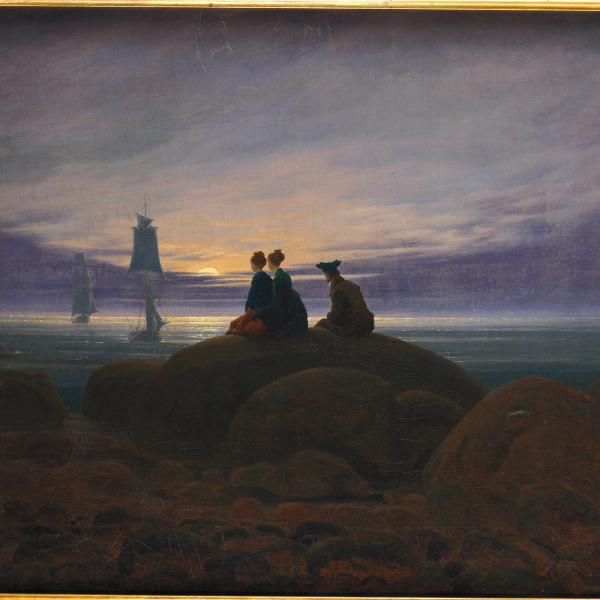Moonrise over the Sea
Artwork Details
- Title: Moonrise over the Sea
- Artist: Caspar David Friedrich (German, Greifswald 1774–1840 Dresden)
- Date: 1822
- Medium: Oil on canvas
- Dimensions: 21 5/8 × 27 15/16 in. (55 × 71 cm)
Framed: 29 7/16 in. × 35 9/16 in. × 4 5/16 in. (74.8 × 90.4 × 11 cm) - Classification: Paintings
- Credit Line: Nationalgalerie, Staatliche Museen zu Berlin (W. S. 53)
- Curatorial Department: European Paintings
Audio

375. Home and Away (Moonrise over the Sea, 1822)
Hear reflections on the play of the everyday and the magical in these works.
NARRATOR: Friedrich was fascinated with complementary oppositions: land and sky, city and nature, light and darkness, what can be perceived and understood, and what remains forever unknowable.
ALISON HOKANSON: In this gallery all around are seascapes and cityscapes in which Friedrich explores how these categories can play with each other.
NARRATOR: Co-curator, Alison Hokanson.
HOKANSON: How can a place like Griefswald, a city that is very familiar, very intimate to him, suddenly become something unknown, something transcendent? How can a simple beach, the simple shore, suddenly open up into this magical world?
ANDREA WULF: There’s a beautiful German word which is called fernweh, which is the longing for the distance. So, fern is the distance, something that’s far away, and weh is pain.
NARRATOR: Romantic historian, Andrea Wulf.
WULF: So, it’s the pain you feel not for wanting to be home, it’s the opposite of feeling homesick. So, it’s the longing for the distance, the longing to be far away, which a lot of people have when they look at the sea, is this kind of longing to be somewhere else.
NARRATOR: At the far end of this gallery, look for a painting of three people sitting on a rock, looking out at the horizon. It’s called Moonrise over the Sea.
HOKANSON: This picture brings together two main motifs that Friedrich juxtaposes, he’s exploring their interplay. That’s the idea of on the one hand of home, this idea of places that are familiar, that are intimate to us, that are everyday, right? This idea of nearness, of things that are tangible, a place where we're really rooted. These boulders are rooted in the soil on the shore.
And then in contrast to this idea of home, this idea of away, of the unknown, of distance, of exploration, of travel. Even the idea of something that’s transcendent or magical. And the idea of yearning for that thing that is maybe just beyond reach.
And in Friedrich's art, home and away are not two separate places, two separate ideals. They really intermingle.
JORDAN B. COOPER: That question of the paradox I think is just one of human life, and I think people will always have to deal with the reality of paradoxes and tensions in the world.
NARRATOR: Lutheran pastor, Jordan B. Cooper.
COOPER: This is an element of Lutheran theology, which is that we use the word mystery and paradox way too much because in some ways we really love to embrace that and let it be… and not to say that there is no resolution, but we don't necessarily know what that resolution is. And I think that that's okay, and we live in the midst of those tensions.
WULF: A lot of problems we have today is that we try to not hold these, what we think are opposites, together. You know, just give them the space to kind of talk to each other, communicate with each other, and kind of feel that there's a great connection between these things that we see as opposites.
There are these cliches that people say, you can only feel happiness once you’ve felt unhappiness. I think it’s a cliche because there's a truth in that. We need to hold these opposites in our heads to really fully experience what this world is about.
###
Music: Schubert, Serenade, performed by Olive Musique. Courtesy of Shutterstock Canada, ULC